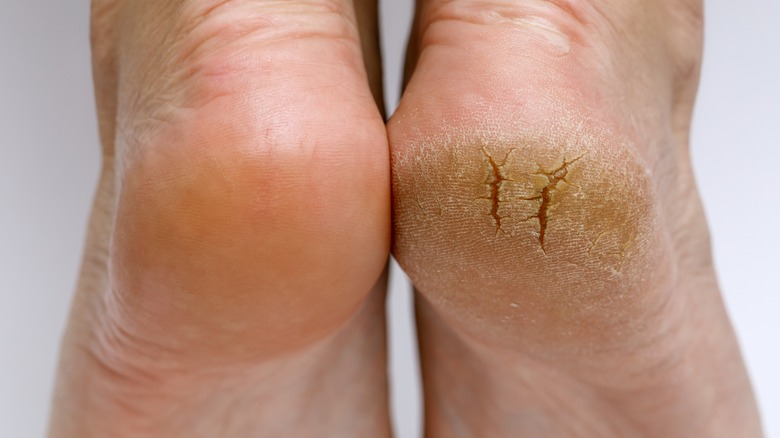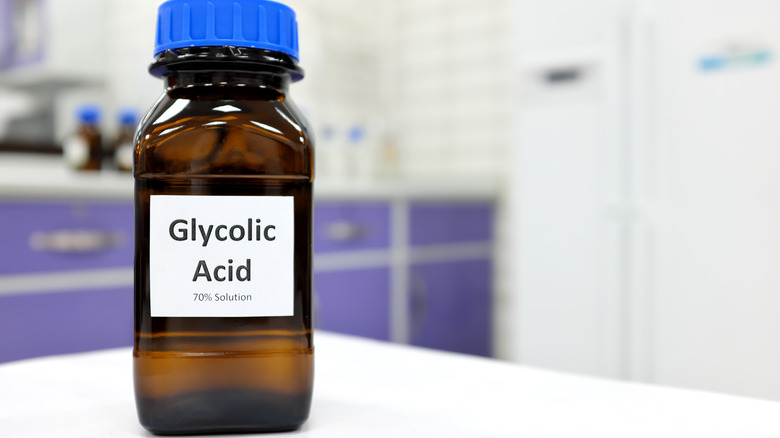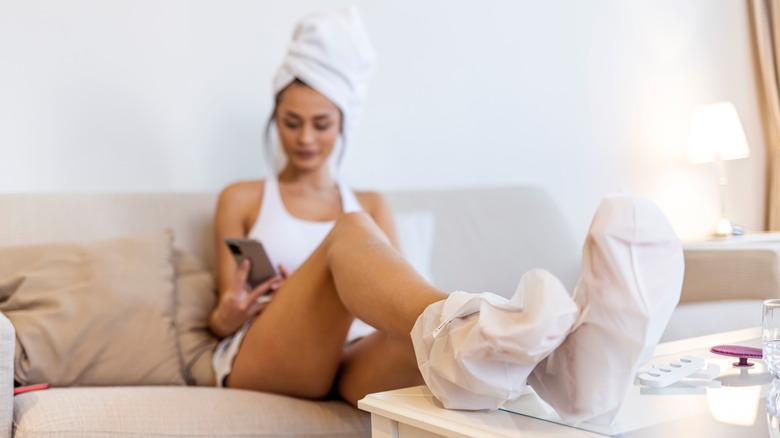Is Glycolic Acid The Secret To Baby-Soft Feet?
Your dry, cracked, and flaky feet present quite the challenge, and you're up to facing it. So you set your favorite moisturizer or cream in front of you and slather away, paying particular attention to the heels of your feet. You know that if you don't, it's probably just a matter of time before it hurts to exert any pressure on them. It will literally hurt to walk. Since you read somewhere that it's a good idea to preserve this infusion of moisture with socks, you wear a pair of wool or cotton socks overnight to keep your feet hydrated (per ISDIN).
You seem to be making all the right moves. And the proof seems to show up on your feet over the next day or two. And then, without warning, your dry, cracked, and flaky feet return — sending you right back to square one. This particular part of your beauty routine has done a U-turn for one simple reason: The dry skin cells on your feet simply cannot absorb the moisturizer. The cells are too thick to be permeated, and so the moisturizer just sits on top, failing to do any good at all, CoastSouthwest says. Worse, dry skin will continue to pile up, and it will probably be a greater force to contend with as it thickens over time.
The long-term solution to this dry-skin conundrum is much easier than you may think, however.
Glycolic acid is no secret; it's the answer
Two words mean the difference between your dry, rough feet and the baby-soft feet you're after: glycolic acid. This substance is a natural exfoliator, meaning that it removes the top layer of (usually dead) skin cells to expose the healthy cells underneath, MedicalNewsToday says.
The word "acid" may incite some trepidation on your part (especially if you're squeamish, to begin with), but it doesn't have to. Glycolic acid is safe, belonging to a group of acids you may have heard of: alpha hydroxy acids (AHAs). You may have heard of AHAs because they're a frequent presence in skincare products that treat fine lines and wrinkles, acne, and UV damage.
Get Healthy Skin calls glycolic acid the "golden standard" of AHAs — so superior is it at removing dead skin cells. It gets to the heart of the problem, and it does so without scrubbing, pain, and the ensuing irritation. It's also available over the counter, though it may be called a "foot peel" (or, as L'Oréal Paris calls it, a "foot peel mask").
After years of applying moisturizer and covering your feet with socks, you may simply call it a miracle.
Taking the long view on soft feet
Depending on the foot peel brand you purchase, the exact procedure may vary somewhat. This is why it's crucial to read the instructions. But the Cleveland Clinic outlines the basic process. It's different from applying moisturizer, and it does require vigilance. But as the experts at CoastSouthwest say, glycolic acid foot peels are not only popular; "these peels work." The potential outcome should be reason enough to take the long view and embrace the differences.
Foot peels often require that you soak your feet in glycolic acid (or a mixture containing the acid) for a short time — say, up to 30 minutes. It may take a while for the exfoliating action to begin working — often about a week. During this time, it may be okay to moisturize your feet as usual. But your feet should stay covered as they shed that top layer of skin — a process that can take up to two weeks. Here, too, it's important to pay attention to the details. A foot peel mask, for example, may require that you soak your feet every day and apply a soothing lotion afterward (per L'Oréal Paris).
It's impossible to say how frequently you may have to repeat the treatment since several factors play a role in the condition of your feet. But dermatologist Shilpi Khetarpal tells Cleveland Clinic that it's realistic to expect repeat treatments every three or four months — all for baby-soft feet in the interim.


